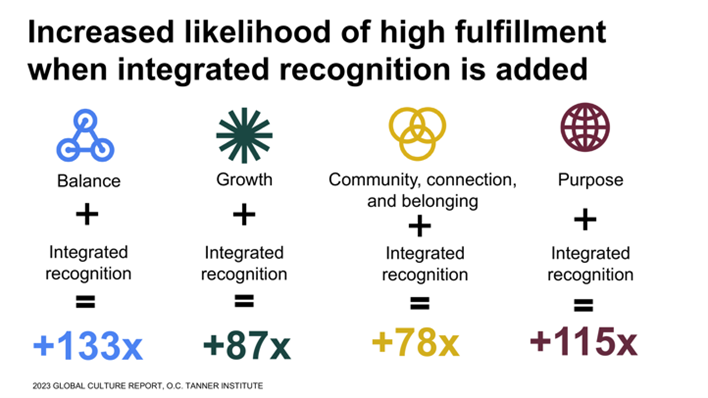
'We want to make sure that we're not offering a sort of 'one-size-fits-all,' blanket approach,' says CHRO at BC Hydro

When to comes to recognition, there’s no one-size-fits-all approach. And there is a wrong way of rewarding your people – even if it is well intentioned.
At BC Hydro, they’re acutely planning a wholesale review of their recognition programs to ensure what they offer is still relevant and meaningful for their people.
“We want to make sure that we’re not offering a sort of ‘one-size-fits-all’, blanket approach,” says Carolynn Ryan, senior VP of people and CHRO at BC Hydro.
“In today's day and age, people really want it to be personal. One option is offering employees a cash amount that they can use for a dinner out, home renovations – an experience they can personalize and make their own. We’re seeing this trend more and more – rather than that old idea of giving an executive a watch on their 15th anniversary.”
It’s not enough to recognise your people once in a blue moon – it needs to be embedded into your organization’s DNA, according to Meghan Stettler, director of the O.C. Tanner Institute.
“HR should seek to integrate recognition into their organization’s culture, so it no longer becomes something that happens once or twice a year but reflects who they are,” she tells HRD. “One of the common pitfalls in achieving high ‘RI’ is the lack of frequency – people simply aren’t being appreciated enough.”
As such, O.C. Tanner’s Global Culture Report set out to uncover just how many times people need to be recognized to achieve a high ‘RI’ culture.
“We discovered that people need to be recognized 35 times per year across formal, informal, and companywide celebrations,” Stettler says. “That seems like a lot, but when you break it down, it’s saying ‘thank you’ three times a month across a range of small and large touch points.
“Having a recognition program that blends the best of technology with human touch allows organizations to deliver consistent, memorable, and meaningful recognition experiences at scale. Technology has ensured that just because people are no longer in the same location, recognition doesn’t fall to the wayside—a deep sense of community can still be created and strengthened with every genuine expression of gratitude.”
And the data’s there to back Stettler’s insights up. Recognition drives that crucial sense of belonging - something which in turn is key to retention. According to O.C. Tanner’s research, belonging increases employee tenure by 83%, boosts employee experience by 40% and diminishes the sense of burnout by a staggering 38%.
But what exactly is the best way to recognize your people?
“I think the most powerful recognition comes from your direct manager,” says Ryan.
“As such, if HR is guiding the organization, they would be supporting managers to ensure that leaders are recognizing their people. It comes down to how should HR be modelling this behaviour? How do we recognize our own staff? Because the way you recognize and acknowledge your employees will directly impact their motivation and their morale – not to mention their desire to stay with the organization.”
Stetter agrees, telling HRD that for true employee appreciation it’s important to embed that sentiment across the whole organization. Something that can only really be done successfully with the best technology.
“Having a recognition program that blends the best of technology with human touch allows organizations to deliver consistent, memorable, and meaningful recognition experiences at scale,” says Stettler. “Technology has ensured that just because people are no longer in the same location, recognition doesn’t fall to the wayside—a deep sense of community can still be created and strengthened with every genuine expression of gratitude.”
Further to that, Ryan says she is interested in ways to gamify rewards – sort of automating recognition through leaderboards and healthy competition.
“That's a trend that we're kind of trying to look into,” she tells HRD. “So I’d be really curious to see if there is some information that comes out on that.”
The best organizations deliver frequent and personalized recognition experiences by focusing on three primary areas that propel meaningful outcomes, according to Stettler.
Everyday efforts: Appreciating little victories builds confidence and lets employees know they are on the right track.
Rewarding results: Recognizing how someone has made a measurable impact or exceeded an expectation validates worth and affirms their potential.
Career celebrations: Honoring contributions over time builds connections and strengthens loyalty.
“Each approach above differs in frequency, visibility, and awards given, but each contributes distinct benefits that when combined, provide a critical mass where employees are giving, receiving, and observing recognition regularly—creating thriving communities of integrated recognition,” says Stettler.
With retention and talent wars consistently on the horizon for HR leaders, it’s incumbent to get a handle on your reward and recognition strategy sooner rather than later. For Stettler, she believes there’s two main rewards trends that employers need to get behind in 2023 to better prepare for 2024.
“The first is leveraging recognition to help employees find fulfillment at work,” she tells HRD. “Increasingly, employees are craving experiences that fulfill their fundamental psychological needs for community, connection, belonging, purpose, growth, and balance.
“Aligning recognition experiences to showcase how individuals belong, deliver meaningful work, are demonstrating mastery, and balancing their lives greatly magnifies feelings of fulfillment and we know from our research that fulfillment is the superior indicator of employee sentiment and their propensity to do great work.”

The second trend, says Stettler, is that of recognizing employees whose diverse skillsets and perspectives often go unnoticed but are crucial to helping organizations navigate change and challenge — the generalists.
“Right now, less than half of generalist employees feel connected to their organization, leader, or team,” she tells HRD.
“Yet, those connections bring their breadth of experience, training, and interdisciplinary thinking to life in ways that uniquely position them to see the bigger picture and connect diverse ideas across the workplace community to find new solutions. It’s no wonder that a loss of connection decreases their odds of great work by 91%.”
How are you rewarding and recognizing your people? Tell us in the comments.